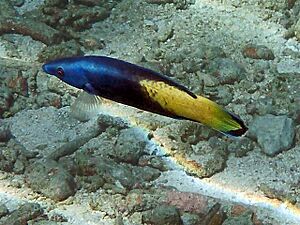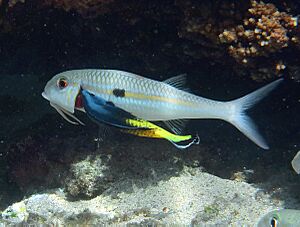Labroides bicolor facts for kids
Quick facts for kids Labroides bicolor |
|
|---|---|
 |
|
| Conservation status | |
| Scientific classification | |
| Synonyms | |
|
Fowlerella bicolor (Fowler & B.A. Bean, 1928) |
The Labroides bicolor is a special kind of wrasse fish. It lives only in the Indian Ocean and the Pacific Ocean. People call it by many names. Some common names are bicolor cleanerfish or two-color cleaner wrasse. It's famous for helping other fish stay clean!
Contents
What Does the Bicolor Cleaner Wrasse Look Like?
This fish has different colors depending on its age and sex. Male Labroides bicolor are black. They have a light color towards the back of their body. Female fish are gray with black markings. Young Labroides bicolor (called juveniles) are bright yellow and black.
Where Does This Fish Live?
The bicolor cleaner wrasse lives in many places. You can find it across the Indian Ocean and the Pacific Ocean. This includes countries like Australia, Japan, Indonesia, and Fiji. It also lives near Africa and many Pacific islands.
Because it lives in so many areas, we don't know the exact number of these fish. But scientists believe there are many of them. They are quite common in most places. However, they are a bit rarer in some parts of the Philippines and Malaysia.
A Fish That Cleans Other Fish!
The bicolor cleaner wrasse loves coral reefs. It lives in shallow reef areas and deeper parts of the ocean. You can find it up to 40 meters deep. Unlike some other cleaner fish, this wrasse travels far to find "clients." It is very active during the day.
This amazing fish helps keep the reef healthy. It eats tiny creatures called ectoparasites. These are like small bugs that live on other fish. It also eats fish mucus, which is a slimy coating on fish. The bicolor cleaner wrasse cleans many different sea animals. It helps fish like striated surgeonfish and parrotfish. It even cleans sharks and rays, such as the grey reef shark!
At night, the bicolor cleaner wrasse has a special way to sleep. It creates a cozy sleeping bag made of mucus. This cocoon protects it while it rests.
When a cleaner wrasse meets another fish, it might do a special "dance." This dance is a way for the wrasse to communicate. It helps calm down bigger fish. This makes the bigger fish feel safe enough to let the wrasse clean them.
Protecting the Bicolor Cleaner Wrasse
The good news is that the Labroides bicolor is not in much danger. Scientists list it as "Least Concern." This means there are plenty of them around.
However, there have been some challenges. In the past, people sometimes caught these fish for aquariums. Also, coral reefs are facing problems in some areas. This can affect where the wrasse lives.
Many places where this fish lives are now protected areas. This helps keep them safe. Scientists are still studying how to make sure these helpful fish stay healthy for a long time.
Images for kids



